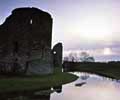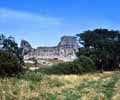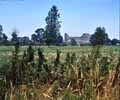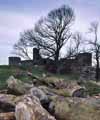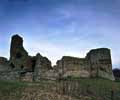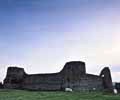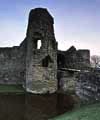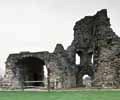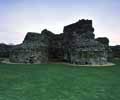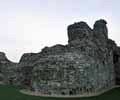Pevensey
East Sussex
As if stranded, high and dry by the sea and forgotten, this castle was once bathed in salt spray at high tide.
Back beyond that era it was an important 3rd century Roman coastal fort,
named Anderidos later to be called Pevensey.
Duke William landed here with his invasion fleet in September 1066, on his way to defeat King Harold and his English army. William later granted the Pevensey fort to his half brother, Robert de Mortain, soon after the consolidation of the south eastern part of England. At this time Mortain raised a castle in the eastern part of the old roman fort. This was probably the first Norman motte and bailey castle to be built in Britain. It consisted of earthworks and a timber tower which was subsequently rebuilt
in stone sometime in the middle to late 12th century.
King William II (Rufus) laid siege to it during the rebellion against his rule in 1088. The castle soon capitulated. Bishop Odo, one of its commanders, was sent by Rufus to Rochester to
command Robert de Bellême to end the rebellion.
In 1101, Pevensey was again the centre of rebellion, but this time against King Henry I, with Robert de Bellême one of its leaders, supporting Duke Robert of Normandy’s claim to the English crown.
Leaving personalities and politics aside, building records for 1161 show
only small amounts of money being spent.
In 1195 Elias the engineer/master mason was employed by Richard, Coeur de Lion and had charge of castle works and may have designed and built the stone keep. At this time he
was receiving at least 2s per week from the royal purse.
Sometime after 1246, Peter of Savoy, the Earl of Richmond, strengthened the castle by building a stone curtain wall with towers, which proved their strength when the castle came under attack, successfully holding out against Simon de Montfort and his forces, after the battle of Lewes in 1264.
In 1271 King Henry III gave Queen Eleanor thirty oaks from the forest of Porchester
for the repair of the castle.
Considerable repairs were still needed in 1289 when further work
was carried out at the queen's own expense.
Between 1291 and 1301 more work was done on the hall, chapel, great tower, outer gate and other works.
Surveys were carried out in 1306 and 1317 revealing the castle’s need of
at least £1,000 to put it in good condition but only
a paltry 200 marks were spent.
1405 the keep was reported to be falling down and repairs were made.
From about 1485, while under the control of the Duchy of Lancaster, the castle gradually fell into a ruinous state and was quarried by the local people for building materials.
It is now in the care of English Heritage and is open to the public.
English &Welsh Castle Picture Search Results
Your Search returned 11 pictures.
Click on a picture to enlarge and order
